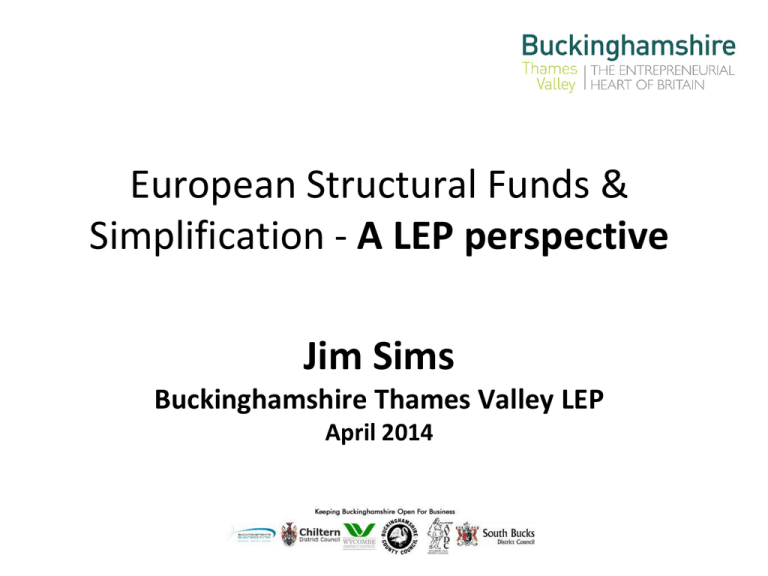Business Plans Comparison / Gap Analysis
advertisement

European Structural Funds & Simplification - A LEP perspective Jim Sims Buckinghamshire Thames Valley LEP April 2014 The boring bit …. BUCKINGHAMSHIRE THAMES VALLEY LEP • Last of 39 LEPs to be awarded • Strong private sector involvement • Ozymandias LEP • Government Facing Strategic Partnership • Smallest ESIF allocation in the country! • No core cities • Secretariat hosted within Buckinghamshire Business First ME • Trained Industrial Designer, moved into Service Design • Over 20 years of working with EU Funding • Background in training, business support, technology transfer • • • • • • 39 LEPs 21 Overlapping 65 + (??) LEADER Groups 2% Technical Assistance (??) 65-ish (?) CLLD’s ? Integrated Territorial Investments ?? • • • • • National Industrial Strategy National Sector Strategies 8 Great Technologies The Witty Review: Universities & Growth Individual localities producing Smart Specialisation Strategies • Structural Fund Investment decisions will underpin the development of some of these capabilities • Planned national platform to support LEPs Tools for effectively managing Localism within the European Programme • An Integrated Territorial Investment is a tool to implement territorial strategies in an integrated way. It is not an operation, nor a sub- priority of an Operational Programme. Instead, ITI allows Member States to implement Operational Programmes in a crosscutting way and to draw on funding from several priority axes of one or more Operational Programmes to ensure the implementation of an integrated strategy for a specific territory. As such, the existence of ITI will both provide flexibility for Member States regarding the design of Operational Programmes, and enable the efficient implementation of integrated actions through simplified financing. The key elements of an ITI are: – a designated territory and an integrated territorial development strategy; – a package of actions to be implemented; and – governance arrangements to manage the ITI. • Community Led Local Development – methodology for delivering bottom-up; publicprivate; integrated; innovative; co-operative investments that are focused on specific sub-regional territories are community-led are carried out through integrated and multisectoral area based local development strategies and takes into consideration local needs and potential. LEP Perspective? • A Flawed construct?? • There is political support for Localism BUT • What documents does the commission recognise? • Who makes the rules? • Who will issue the calls? • Who makes the final investment decision? • Who is designing the business processes? • What is the minimum size of bid? • Will there be a single application process? • Many of these questions won’t be resolved for a few months LEPs will be responsible for; • Developing an overarching strategy; • Developing an Annual Delivery Plan; • Working with partners to – Establish Local Investment Committee’s; – Develop project specifications; – Have a role in the Appraisal process; – Monitor and review project performance • Playing a part in guiding the process; ? • • • • • • • • • • • Get involved! Ask not what a LEP can do for you, but what you can do for a LEP! Seek representation on the Local Investment Committees Typologies of LEPs will likely start to emerge – Sovereign States? – Federations? Understand the local politics Understand the local strategies (including Smart Specialisation Strategies) Try and build cross LEP programmes, with partners (where appropriate); Involve the LEP Executive(s) in your thinking Understand the national processes (as they emerge) Understand the intervention costs Use the national ‘Check and Challenge’ structures (where necessary) Thank you Any questions?











